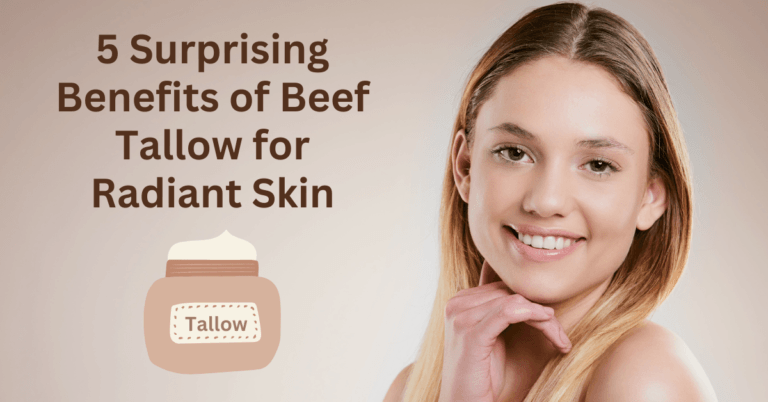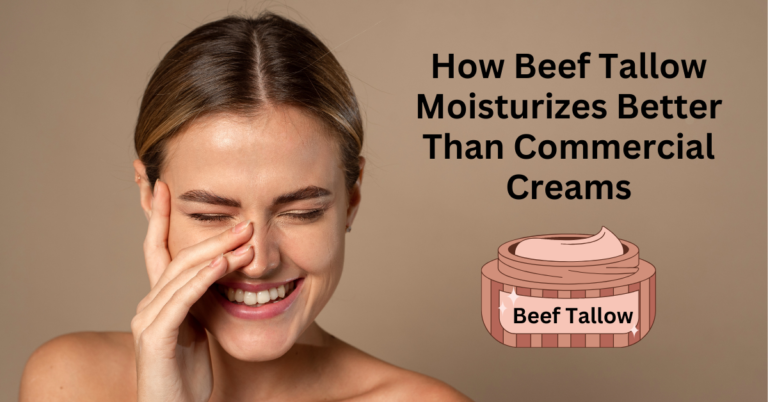Beef tallow and shea butter have been star ingredients in natural skincare for years. Both are known for their nourishing and moisturizing properties, but they come from very different sources. In this article, I check out the benefits, drawbacks, and ideal uses for each, helping you decide which ingredient might work best for your skin. Whether you have dry, mature, or sensitive skin, understanding these ingredients can make your skincare routine more effective and enjoyable.
Overview of the Natural Ingredients
What is Beef Tallow?
Beef tallow is rendered fat that comes from cattle. Traditionally used for cooking, it has also been employed in skincare for centuries. Tallow is rich in fatty acids that are similar to those found in human skin, making it excellent for nourishing and restoring the skin’s barrier. It has a smooth, creamy texture that absorbs well, promoting hydration while also helping to lock in moisture.
Who Might Prefer Beef Tallow?
- People with dry, mature skin looking for deep hydration
- Those who favor natural ingredients with minimal processing
- Individuals who appreciate traditional, time-tested skincare methods
Beef Tallow Pros & Cons
Pros:
- Rich in fatty acids that mimic the skin’s natural lipids
- Helps restore the skin’s barrier and lock in moisture
- Offers a natural and minimally processed remedy
Cons:
- Has a distinctive scent that might not appeal to everyone
- May feel heavy on the skin if overapplied
- Not suitable for those who prefer plant-based products
What is Shea Butter?
Shea butter is a fat extracted from the nuts of the shea tree, native to Africa. This natural butter is prized for its emollient properties and high content of vitamins A and E. It provides a luxurious texture that softens the skin, aids in healing, and adds a natural glow. Shea butter is widely used in moisturizers, lotions, and various skincare treatments because it works well for a range of skin types, especially dry and irritated skin.
Who Might Prefer Shea Butter?
- People with sensitive or dry skin needing gentle hydration
- Those who appreciate naturally derived, plant-based skincare products
- Individuals interested in ingredients that also support skin healing
Shea Butter Pros & Cons
Pros:
- Deeply moisturizing with high levels of vitamins and antioxidants
- Smooth texture that is easy to apply and absorbs well
- Helps soothe and heal irritated or inflamed skin
Cons:
- Can sometimes feel greasy if not formulated correctly
- May leave a slight residue on the skin, especially in humid climates
- Extraction and processing practices vary, affecting quality
Key Feature Comparisons
1. Nutrient Composition & Fatty Acids
Why It Matters: The fatty acid profile of a lipid ingredient plays a key role in skin hydration and barrier protection. Beef Tallow: Contains a mix of saturated and monounsaturated fats that are similar to the lipids naturally found in human skin. This similarity helps in creating a protective layer that retains moisture. Shea Butter: Rich in unsaponifiables, vitamins A and E, and essential fatty acids that promote skin cell regeneration and softening. Winner: Both excel in nutrient content, though beef tallow may appeal more if matching your skin’s natural composition is a priority. On the other hand, shea butter wins if you need added vitamins and antioxidant benefits.
2. Moisturization & Skin Barrier Support
Why It Matters: Hydration is key for preventing dryness, flakiness, and irritation. Beef Tallow: Works by forming a protective layer on the skin, helping to reduce moisture loss. This makes it particularly effective for tough, dry patches and for mature skin that loses elasticity. Shea Butter: Provides a deep, penetrative moisturization without leaving the skin too oily. Its soothing properties are beneficial for irritated and eczema-prone skin. Winner: Shea butter tends to be favored for its light texture and healing properties, though beef tallow is a heavyweight champion in sealing in moisture.
3. Absorption & Application
Why It Matters: How a product feels on the skin is important for daily use, especially if you apply it often. Beef Tallow: Has a rich, creamy texture that absorbs relatively slowly, making it suitable for evening routines or targeted treatment on extremely dry areas. Shea Butter: Absorbs more quickly and leaves a smoother finish, which makes it popular as a base in many skincare products. Winner: Shea butter wins if quick absorption and a lighter feel are important for your daily routine.
4. Scent & Texture
Why It Matters: The smell and feel of a skincare ingredient can influence how much you enjoy using it. Beef Tallow: Has a natural, subtle beef scent that can be off-putting for some but often fades quickly with use. The texture is rich and can feel slightly heavy for those not used to animal-based products. Shea Butter: Offers a mild, nutty fragrance that many associate with natural skincare. Its texture is smooth and easily spreadable, appealing to those who like a quick application without residue. Winner: Shea butter tends to have an edge because of its pleasant scent and lighter feel on the skin.
5. Cost & Availability
Why It Matters: Practicality matters in everyday skincare. The frequency of use and overall budget can determine which ingredient is more sustainable for you. Beef Tallow: Often available through local butchers or specialty suppliers. It is generally affordable, especially if you opt for traditional, unrefined versions. Shea Butter: Widely available in both raw and processed forms. Prices can vary depending on the quality and source, but many high-quality options are reasonably priced. Winner: The choice here depends largely on local availability and personal preference. In many cases, shea butter’s versatility and range of products give it a slight advantage.
User Reviews & Reputation
Feedback from users and skincare enthusiasts offers valuable insights. Many people appreciate beef tallow for its ability to create a natural barrier that locks in moisture and mimics the skin’s needs. It is often mentioned in traditional and artisanal skincare communities.
Conversely, shea butter has a broader appeal due to its lighter feel and widespread availability. Its healing and anti-inflammatory properties make it a favorite among those with sensitive or problematic skin.
Overall Reputation: Both ingredients enjoy positive reviews. The choice often depends on individual skin type and personal lifestyle. Users with a preference for animal-derived, traditional methods lean toward beef tallow, while those seeking a plant-based, versatile ingredient often choose shea butter.
Final Verdict: Which One Should You Choose?
Both beef tallow and shea butter offer natural solutions to moisturizing and protecting the skin, but each has strengths tailored to different needs. Consider beef tallow if you have very dry, mature skin that benefits from a rich, sealing barrier, prefer ingredients that closely match human skin lipids, and value traditional, tried and true skincare methods. On the other hand, if you seek a lighter, faster-absorbing moisturizer, prefer plant-based alternatives, and need a product that also supports healing and calms irritation, shea butter is likely the better choice.
Your personal skincare routine, local environment, and personal ethics all play a role in making the right choice. Experimenting with both on a small area of your skin can be a useful approach to see which one feels best for your unique needs.
Final Thoughts
Choosing between beef tallow and shea butter is not as simple as declaring one universally superior. Each brings its own unique set of benefits to the table. If you are drawn to ingredients that are robust and time-tested with a texture that feels rich and sealing, beef tallow might be the better option. Meanwhile, if you lean towards a smoother, quicker-absorbing product that supports skin healing, shea butter will likely suit you more.
Skin differs for everyone, so what works well for one person might not be the best for another. Taking the time to understand your individual skin needs will help guide your decision. I hope this comparison has shed some light on the subject and helped you feel more confident in making a natural choice for your skincare routine.
Which one do you prefer? Feel free to share your thoughts and experiences with either ingredient!
Extended Insights and Practical Applications
To give you a more all-in-one perspective, it is important to examine how these ingredients have evolved over time and how modern research continues to back up their benefits. Historically, beef tallow was a staple in many households not just for cooking but also for caring for the skin. Many cultures relied on animal fats for keeping the skin soft and protected against environmental factors. Today, modern formulations have refined tallow into products that remain true to their origins while offering improved textures and subtle, natural aromas.
Similarly, shea butter has a long tradition in African skincare rituals. Extracted from the nuts of the shea tree using centuries-old methods, this butter has been cherished as a remedy for dry, irritated skin. In more recent years, research has underlined the antioxidant properties and skin-regenerating capabilities of shea butter, further solidifying its reputation as a go-to moisturizer for numerous skin types.
In terms of application, both ingredients can be integrated in versatile ways. For instance, you might choose to use beef tallow as an overnight treatment for areas prone to harsh dryness, taking advantage of its ability to form a protective barrier. On the other hand, shea butter’s lighter feel makes it more suitable for daytime routines or as a base for blended moisturizers where quick absorption is preferred. Many users have also found success by mixing a small quantity of each, effectively combining the rich hydration of beef tallow with the healing boost of shea butter.
How to Incorporate These Ingredients Into Your Routine
If you are considering incorporating these ingredients into your daily regimen, it is very important to start with a patch test. Begin by applying a small amount on your wrist or behind your ear to ensure you do not experience any adverse reactions. Once you determine your skin’s sensitivity, you can gradually increase usage and even experiment with blending the two ingredients to tailor the experience.
For those who enjoy a DIY approach, creating your own skincare mixtures at home can be both a rewarding and educational process. Start by melting a small amount of beef tallow and blending it with freshly softened shea butter. This combination can then be gently massaged into the skin to promote deep moisturization and barrier repair. Many enthusiasts also add natural essential oils for an added aromatic twist and extra skin benefits. Both ingredients have their distinct advantages, and learning how to mix them based on your skin’s evolving needs can truly take your routine to the next level.
Looking Ahead: Trends and Future Directions
As consumer interest in natural and sustainable skincare continues to grow, the spotlight on traditional ingredients like beef tallow and shea butter is only set to get brighter. Today’s market trends point towards a blend of age-old wisdom with modern science, ensuring that these natural products are not only safe but also highly effective for a wide demographic. News outlets and social media platforms are abuzz with testimonials and user reviews, further validating the longstanding benefits of these ingredients.
Moreover, innovations in formulation are paving the way for products that are more refined and targeted. Researchers are now able to optimize these ingredients to maximize absorption and efficacy while minimizing any potential drawbacks. This next stage of skincare evolution offers consumers the best of both worlds: the reliability of traditional remedies combined with the convenience of modern aesthetics and precise formulation techniques.
Wrapping up, whether you rely on beef tallow for its rich, protective qualities or lean on shea butter for its gentle yet effective moisturization and skin healing properties, both ingredients stand as testament to the power of natural skincare. With a balanced approach and attentive experimentation, you can build a routine that not only pampers your skin but also connects you with time-honored traditions and modern innovations alike.




